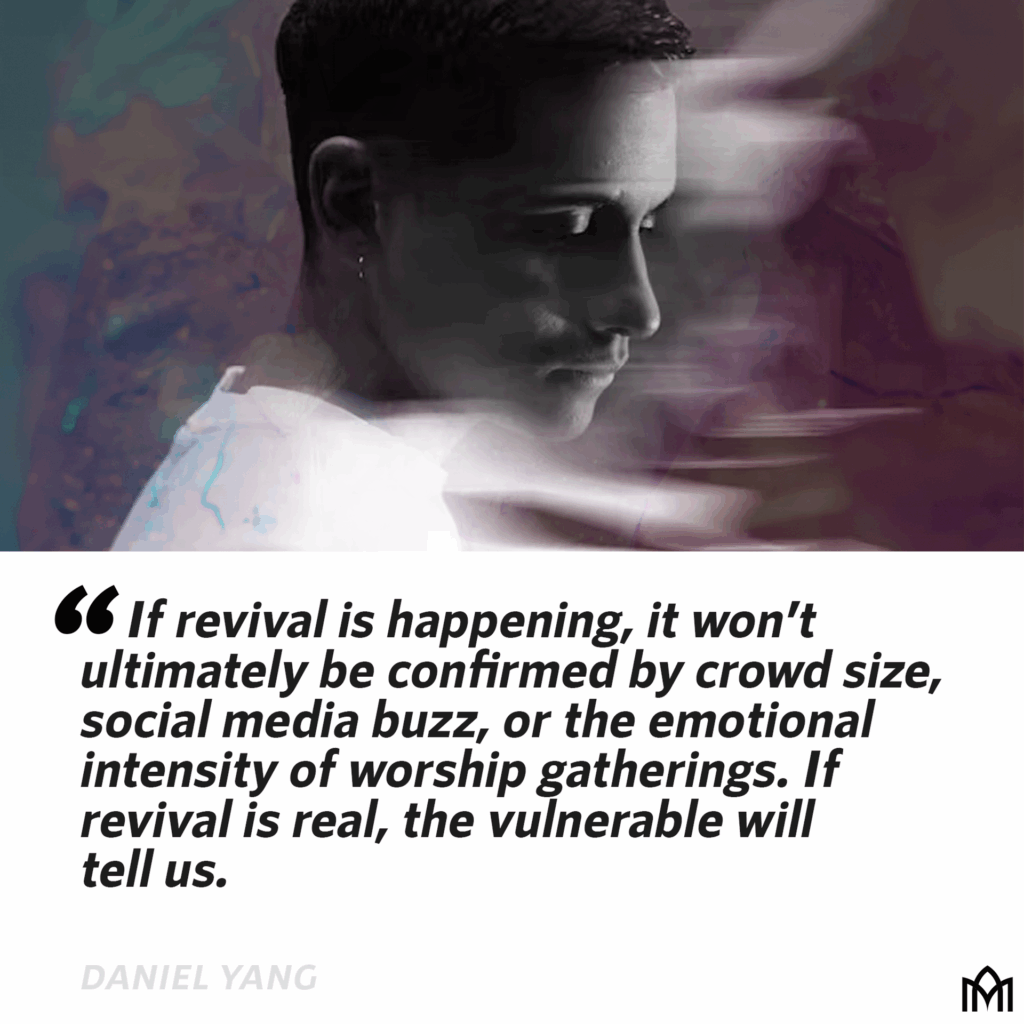If Revival Is Real, the Vulnerable Will Tell Us
There’s a lot of talk online about revival right now. We’ve seen in our newsfeeds and social media, stories of packed university student gatherings, increased church attendance among Gen-Z, and popular podcasters talking about Jesus and the Bible.
Like many, for decades I’ve prayed, gathered, and yearned for a movement of the Holy Spirit that awakens hearts, renews the church, and transforms our world. So, when I hear about revival, I want it to be true. I really do. But if revival is happening, it won’t ultimately be confirmed by crowd size, social media buzz, or the emotional intensity of worship gatherings.
If revival is real, the vulnerable will tell us.
The epistle of James gives us one of the most sobering litmus tests of genuine faith: “Religion that God our Father accepts as pure and faultless is this: to look after orphans and widows in their distress and to keep oneself from being polluted by the world” (James 1:27).
James doesn’t equate holiness with doctrinal purity alone or passionate worship alone. He roots true religion in proximity to suffering—in how the people of God respond to those who can’t repay, who live on the periphery of the evangelical gaze, who are easy to overlook. For James, the evidence of God’s life among us is measured not simply by our spiritual enthusiasm but by our embodied compassion and uncompromised integrity—individual and corporate.
Repentance is a key marker of revival, and so as it happens, we should expect the hearts of God’s people to turn away from what grieves Him. That has often been the case with previous revivals.
Revival and the Margins
Historically, every authentic revival has had ripple effects among the poor, the displaced, and the oppressed. The Great Awakening in the 18th century didn’t just fill churches—it also inspired movements for prison reform and the abolition of slavery. The Welsh Revival of 1904-1905 birthed community renewal that transformed the working class. The Azusa Street Revival in 1906 broke racial and gender barriers, creating a multiethnic, Spirit-filled community that defied the segregationist norms of the time.
When the Holy Spirit revives the people of God, the social order begins to shift. Those who were invisible become seen. Those who were forgotten are named. Those who were left out are invited in.
That’s why I’m cautious—not cynical, but discerning—when I hear widespread talk of revival in the American church. Because while there may be genuine spiritual fervor, the question James would push us to ask is not, “Are people singing louder?” but “Are the vulnerable safer?”
(And I want to say “Yes!” to both.)
If we are experiencing the first fruits of a genuine move of God, the fruit will show up in how we treat the single mother dependent on SNAP, the struggling family who may lose Medicaid, and children whose undocumented parents were recently snatched in broad daylight by ICE.
If revival is happening, it won’t ultimately be confirmed by crowd size, social media buzz, or the emotional intensity of worship gatherings. If revival is real, the vulnerable will tell us. Share on X
The Great Commission and the Great Commandment Meet the Great Displacement
At World Relief, we see the intersection of global displacement and local discipleship every day. Nearly 123 million people around the world are currently displaced from their homes—the highest number in recorded history. These are not statistics; they are Image-Bearers of God: families fleeing war in Sudan, mothers escaping gender-based violence in Central America, and young women and men leaving their homelands because of persecution or hunger.
And what’s remarkable is how many of these Image-Bearers are arriving in American cities right now—the very same cities where churches are praying for revival. For decades Americans yearned for revival; but were caught unaware when it arrived in their cities with Black and Brown skin.
What if the Spirit is already answering that prayer, not just in church sanctuaries, but also churches as places of sanctuary? What if revival looked like a congregation in Kentucky sponsoring an Afghan family? What if it looked like a small-town church in Texas welcoming asylum seekers with hot meals and hugs? What if it looked like congregations choosing presence over fear, compassion over convenience?
The Great Commission and the Great Commandment are converging in what has become the Great Displacement—nearly 1 in 70 people in the world who have been forced to flee from their homes because of persecution, war, violence, or catastrophe. The nations that many churches spent years sending short-term mission teams to are literally at our doorstep.
True religion lives in proximity to suffering. The evidence of God’s life among us is measured not simply by our spiritual enthusiasm but by our embodied compassion and uncompromised integrity—individual and corporate. Share on X
The Test of Revival Is Justice
There’s a deep biblical current that connects revival and justice. The prophet Isaiah put it bluntly: “Is not this the kind of fasting I have chosen: to loose the chains of injustice…to set the oppressed free and break every yoke?” (Isaiah 58:6).
God’s presence among His people always disrupts unjust systems. Keeping systems “from being polluted by the world” is another way to apply James’ understanding of religion that is acceptable. When the Spirit fills the church, the church becomes an agent of repair. So, if the Spirit is stirring revival in our day, we should expect to see the modern equivalents of orphans and widows—the vulnerable, the disenfranchised, the displaced—being lifted.
A revived church will not merely tolerate the poor; it will move toward them. It will repent of indifference. It will refuse to build revival on top of injustice.
In the American context of 2025, that means a revived church must wrestle with things such as a broken immigration system, but also capitalistic economic systems that disadvantage single mothers, the more than 340,000 children in U.S. foster care, and the 15 million orphans around the world. These are current realities within our world. The church must not wrestle with them only as political talking points, but as spiritual realities that grieve the heart of God.
When the Holy Spirit revives the people of God, the social order begins to shift. Those who were invisible become seen. Those who were forgotten are named. Those who were left out are invited in. Share on X
Revival as Proximity, Not Platform
When we celebrate increased religious fervor (as we should!), we must also resist the temptation to equate revival with virality. We assume that if something is spreading fast, it must be God. But spiritual awakening doesn’t always trend. It often happens on a quiet scale, in the margins of society, in places that don’t make national headlines.
I’ve seen awakening in the faces of pastors who, instead of growing their church by addition, chose to grow their compassion by multiplication—sharing their resources with new immigrant congregations meeting in their basements. I’ve seen awakening in volunteers who teach English to refugee moms learning how to navigate a new culture. I’ve seen it in churches that stop asking, “How do we get people to come here?” and start asking, “How do we go where people already are?”
That’s the Spirit’s work.
Revival that never touches the streets doesn’t graduate from performative to transformative.
For decades Americans yearned for revival; but were caught unaware when it arrived in their cities with Black and Brown skin. What if the Spirit is already answering that prayer, not just in church sanctuaries, but also churches as… Share on X
A Revival Worth Praying For
By all means, we should keep praying for revival, optimistic that it may be happening. But let’s be clear about what we’re praying for. We’re not asking for a sentimental return to cultural Christianity (Do a deep dive into Søren Kierkegaard and why cultural Christianity is not true religion). We are also not asking for nostalgia-fueled movement that makes us feel in power and control once again. We’re asking for the kind of holy disruption that reorients our lives around Jesus and His mission to the least of these.
That kind of revival won’t just renew our souls—it will reorder our budgets, our calendars, and our policies. It will push us out of convenience and into compassion. It will cause the comfortable church to repent, reconcile, and re-engage the world as the hands and feet of Christ. Because when the Spirit moves, the poor rejoice, the oppressed breathe easier, and the Church remembers who she really is.
Again, James reminds us that true religion is both transformative and consecrated, as it is “to look after orphans and widows in their distress and to keep oneself from being polluted by the world.”
That’s the balance: Mercy and holiness. Justice and righteousness.
The church cannot be polluted by the world’s apathy or self-protection. Nor can it remain pure by withdrawing from the world’s problems. The purity that God desires is forged in proximity to pain. It’s there, among the brokenhearted and displaced, that revival fire burns hottest.
So yes, let’s believe in revival—but let’s bring it about both with our prayers and with our witness. Let’s look for it not just in our sanctuaries, but in shelters, dining rooms, and border towns. Because if the vulnerable aren’t saying, “We have been seen, loved, and lifted,” then it’s not yet pure and faultless religion.
But when the vulnerable begin to testify that the Church has shown up—not just with words but with incarnational presence—then we can say, with humble confidence, that revival has come.
///
*Editorial Note: I have been waiting for the right Christian leader–one full of character, integrity, and who has long been involved in direct care for the most marginalized in our midst–to pen this exact sort of piece. When I saw Daniel Yang make the statement, “Lots of talk of revival. I hope and pray that it’s happening. Because if it is, the vulnerable will tell us,” I sat up straight in my chair and immediately reached out. I am grateful to Daniel for his prophetic, challenging look at revival in our cultural moment, and for his heart to see the Church move closer in proximity to our most vulnerable neighbors. Check out his work with World Relief. ~CK
A revived church will not merely tolerate the poor; it will move toward them. It will repent of indifference. It will refuse to build revival on top of injustice. Share on X




